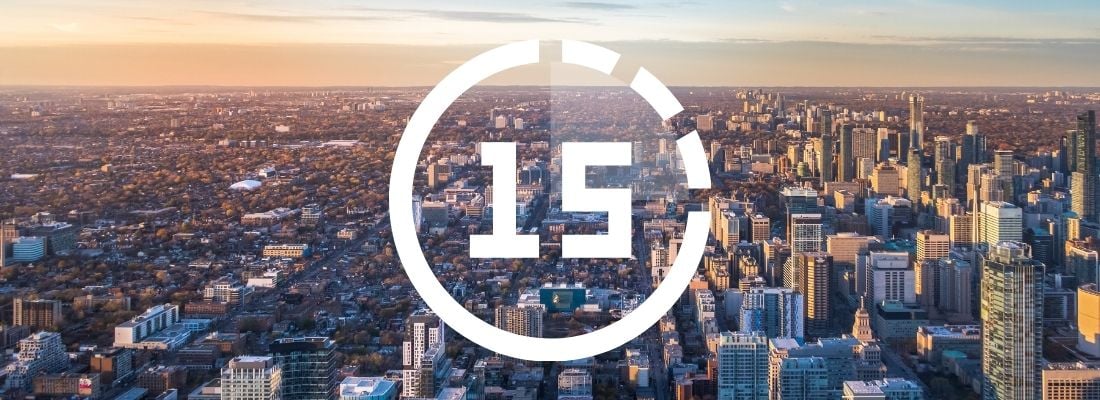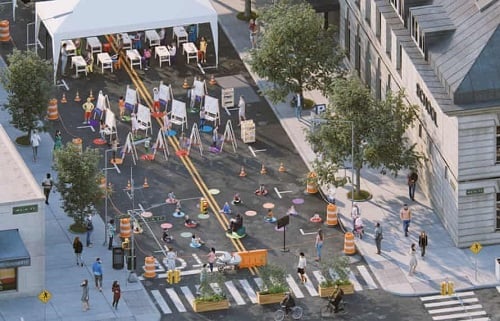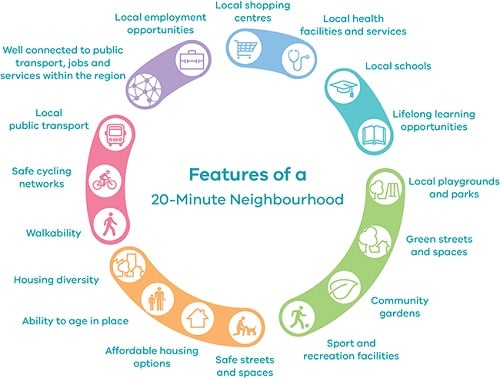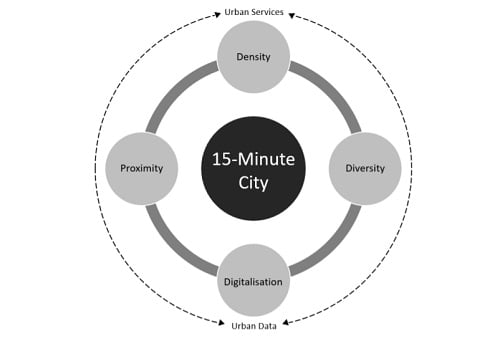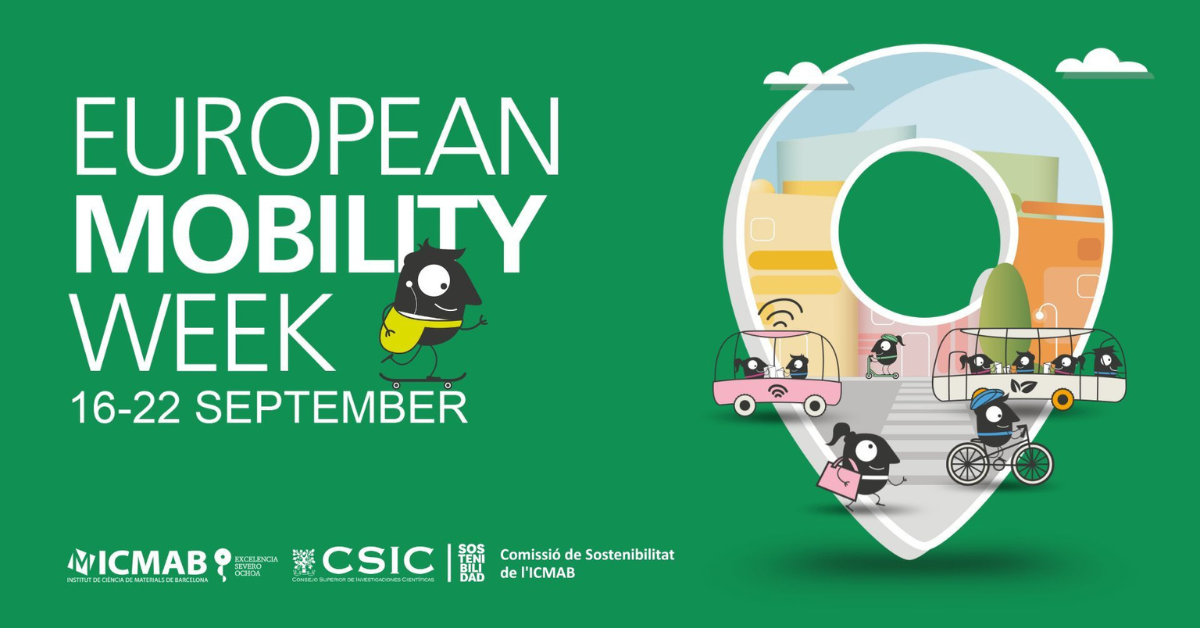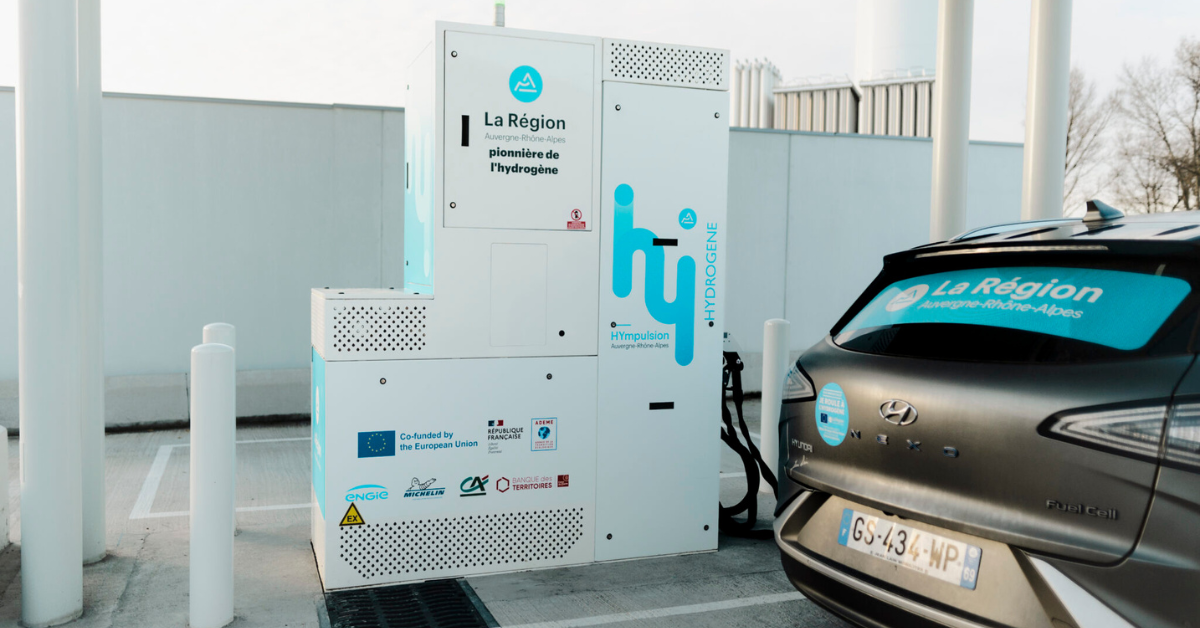15 Minute city: urban mobility solution to the environment?
By 2050, almost 70% of the people are projected to live in urban areas. In most modern cities, the space is designed to allow fast traffic flow, especially aimed at the car. A large part of the public space is occupied by roads that have to take you quickly from A to B. Unfortunately, people lose a lot of time in city traffic jams. The role of cities is admittedly decisive in a paradigm shift, since urban areas are responsible for 70% of emissions. With our cities expected to grow, some experts agree that new urban planning is necessary in order to improve quality of life and save the environment.
Desde el estallido de COVID, e incluso antes, ciudades como Copenhague y París han ido introduciendo nuevos modelos urbanos. Desde ciudades sin coches a supermanzanas, pasando por la ciudad compacta o la ciudad de 15 minutos. Todos los modelos parecen tener el mismo objetivo: dar prioridad a los desplazamientos a pie y en bicicleta para que las ciudades y sus ciudadanos estén más sanos.
CUIDAD COMPACTA
Las ciudades compactas se caracterizan por una mayor densidad residencial, distancias más cortas y mayor diversidad. Al ofrecer oportunidades de movilidad más saludables, diversificar el uso del suelo y acortar los desplazamientos, la ciudad se vuelve más compacta aumentando la calidad de vida.CIUDAD SIN COCHES
En las ciudades sin coches, los gobiernos pretenden reducir el uso de vehículos motorizados de propiedad privada y motivar a la gente para que utilice un transporte activo y público que facilite el acceso. Mediante la reducción de la contaminación atmosférica y el aumento de los desplazamientos físicos, la ciudad de Hamburgo planea estar libre de coches en 2034.SUPERBLOCKS
Un “Superblock” es similar a un barrio con poco tráfico. En determinadas manzanas se prohíbe el tráfico motorizado y se deja más espacio para los desplazamientos activos, las personas y las zonas verdes. En Barcelona, el gobierno tiene previsto crear más de 500 supermanzanas, lo que se calcula que evitará 700 muertes prematuras al año en la ciudad.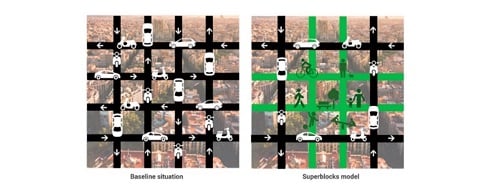
QUE ES UNA “15 MINUTE CITY”?
Una ciudad de 15 minutos es una ciudad que requiere desplazamientos mínimos entre casas, parques, oficinas, restaurantes, escuelas. Todos los servicios esenciales se encuentran a 15 minutos a pie o en bicicleta. Independientemente de si se vive en el centro o en otro barrio, cada barrio cumple seis funciones sociales: vivir, trabajar, abastecerse, cuidar, aprender y disfrutar. Entre los servicios esenciales se incluyen:
- Trabajo
- Comercios
- Sanidad
- Escuelas
- Equipamientos culturales
- Deportes y ocio
- Parques
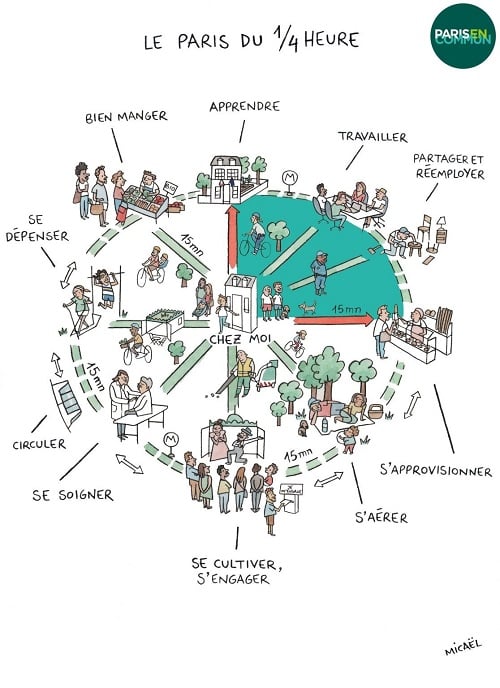
Fuente: París en Común "Ciudad en 15 minutos". Desde arriba, en el sentido de las agujas del reloj, los títulos son: Educación, Trabajo, Intercambio de conocimientos, Compras, Ocio, Participación comunitaria, Salud, Transporte público, Ejercicio y Nutrición. (Crédito de la imagen: Ubique)
LA IDEA
Uno de los impulsores de la ciudad de 15 minutos es Carlos Moreno, científico de la Escuela de Negocios de la Sorbona y experto en urbanismo. Quiere conseguir dos cosas: mejorar la calidad de vida en la ciudad y, al mismo tiempo, reducir la carga sobre el medio ambiente. En la ciudad de 15 minutos que imagina Moreno, la gente gasta menos tiempo y energía en desplazarse. Hay más tiempo y espacio para conocer gente. Además, hay poco tráfico de coches, lo que se traduce en menos emisiones. Para ofrecer esta calidad de vida, según Carlos Moreno una ciudad de 15 minutos consta de cuatro principios fundamentales: densidad, proximidad, diversidad y ubicuidad. Estos componentes atraviesan las seis funciones urbanas sociales esenciales antes mencionadas.
DENSIDAD
En una forma convencional de planificación la densidad se entiende como edificios de alta densidad, pero en una ciudad de 15 minutos está relacionada con el número de personas por kilómetro cuadrado. Una densidad óptima ayuda a planificar eficazmente el espacio urbano disponible y a garantizar la disponibilidad de lo esencial sin necesidad de recurrir al automóvil.
DIVERSIDAD
La dimensión de la diversidad tiene dos vertientes: (i) la necesidad de barrios de uso mixto que sean primordiales para ofrecer una mezcla saludable de componentes residenciales, comerciales y de ocio y (ii) la diversidad en cultura y personas.
PROXIMIDAD
Esta dimensión ayuda a las ciudades a reducir el tiempo perdido en los desplazamientos y a reducir el impacto medioambiental y económico. Además, ayuda a determinar los indicadores sociales que afectan a los residentes urbanos.
UBIQUIDAD
Los barrios deben estar disponibles y al alcance de cualquiera.Moreno menciona también tres características de una ciudad de 15 minutos: El ritmo de la ciudad se adapta a las personas, no a los coches. Cada metro cuadrado de espacio disponible se utiliza de múltiples maneras. Los barrios están diseñados para que puedas vivir, trabajar y recibir tus servicios diarios sin estar constantemente en la carretera.
No me malinterpreten, no pretendo que las ciudades se conviertan en aldeas rurales. La vida urbana es vibrante y creativa. Las ciudades son lugares de dinamismo económico e innovación, pero tenemos que hacer que la vida urbana sea más agradable
EJEMPLOS
Las ciudades que quieran convertirse en una ciudad de 15 minutos no tienen por qué transformarse de golpe. El concepto es, por definición, adecuado para su aplicación a nivel de barrio o distrito. Esto hace posible una remodelación gradual de la ciudad. Las ciudades pueden aplicar las ideas de la ciudad de 15 minutos en los planes existentes de nueva construcción y reurbanización de los distritos urbanos. Ejemplos de ciudades que ya lo están aplicando son París, Barcelona, Melbourne, Ottawa, Nueva York y Copenhague.
PARÍS
Carlos Moreno dice que en París, el 66% del espacio público son calles para coches. Pero los coches individuales solo mueven al 17% de la población. El objetivo de la alcaldesa de París, Anne Hidalgo, ha sido mejorar la calidad de vida desde su nombramiento en 2014. Antes prohibió el tráfico de coches en algunas partes del Sena y en febrero de 2020 anunció que quiere convertir París -ciudad de 2,2 millones de habitantes- en una ville du quart d'heure, una ciudad de 15 minutos, e incluso nombró a un comisario para la ciudad de 15 minutos.
BARCELONA
En Barcelona, el 60% del espacio público se utiliza para alojar coches. Sin embargo, sólo uno de cada cuatro desplazamientos se hace en coche. Según la teniente de alcalde Janet Sanz, en una reciente encuesta del gobierno local, el 90% de la población está a favor de medidas de espacio público para uso de peatones, bicicletas y transporte público. Así, pretende destinar el espacio a fines más saludables. Barcelona es, en muchos sentidos, una ciudad de 15 minutos que aplica las supermanzanas con éxito.

Foto: Una visualización de cómo podría funcionar una calle escolar socialmente distanciada. Fotografía: Nacto/Bloomberg Associates
NUEVA YORK
La ex Comisaria de Transportes Janette Sadik-Kahn considera que el siguiente paso para Nueva York es recuperar las calles utilizándolas como aulas al aire libre, centros de votación y cualquier actividad al aire libre. Las carreteras deben ser tan adaptables como la propia ciudad. "En el departamento de transportes de Nueva York, donde trabajé bajo las órdenes del alcalde Mike Bloomberg, consideramos los 9.656 km de calles de la ciudad como activos fundamentales que podían utilizarse para algo más que mover y aparcar coches. En menos de siete años, creamos 644 km de carriles bici, siete líneas de autobuses rápidos y pusimos en marcha 70 plazas en toda la ciudad, recuperando 73 hectáreas de antiguo espacio urbano."
OTTAWA
La ciudad de Ottawa puso en marcha en 2019 un plan de crecimiento a 25 años para crear barrios de 15 minutos. Aprende de ciudades como Copenhague, Ámsterdam y Portland. Su objetivo es que los residentes realicen más del 50 % de sus desplazamientos a pie, en bicicleta, transporte público o coche compartido. Actualmente, entre el 40 % y el 50 % de los desplazamientos diarios de sus residentes se realizan en un medio de transporte distinto del vehículo personal.
COPENHAGE
Copenhague peatonalizó su principal calle comercial en 1962. El barrio de Nordhavn se ha diseñado como un distrito de 5 minutos. En los próximos 50 años, el distrito se ampliará para ofrecer a 40.000 habitantes 40.000 lugares de trabajo. Tiendas, instituciones, lugares de trabajo, instalaciones culturales, transporte público: todo a 5 minutos a pie desde cualquier punto del distrito. La zona contará con una vía de metro elevada y una red ciclista que crearán una arteria verde. La vía elevada funciona como cubierta de la autopista ciclista, de modo que los ciclistas podrán mantenerse secos en cualquier condición meteorológica.
MELBOURNE
En 2018 Melbourne presentó el programa piloto de barrios de 20 minutos. El barrio de 20 minutos trata de vivir localmente y aumentar la calidad de vida. Melbourne eligió la distancia de 20 minutos porque la investigación mostró que este es el tiempo máximo que las personas están dispuestas a caminar para acceder a las necesidades diarias a nivel local. Esto representa 8,000 metros a pie desde el hogar hasta un destino y viceversa. Varios proyectos piloto se entregaron en 2018 en tres áreas con informes y recomendaciones para ver aquí.

EN LA PROXIMIDAD
Un nuevo modelo urbanístico que puede cambiar una capital y cuyo objetivo es reducir las sustituciones. Suena familiar y muy reciente, ¿verdad? Quedarse en tu propia zona es algo que llevamos haciendo desde los encierros, ¿no? Carlos Moreno : "COVID-19 ha acelerado la implantación de la ciudad de 15 minutos en muchas ciudades, gracias al redescubrimiento de la proximidad, el uso de la movilidad activa y el fortalecimiento de los vínculos sociales". Limitarse a un radio de sólo 1 km de tu casa puede ser refrescante. Conoces tu barrio y compras a comerciantes, artesanos y empresarios locales. Esto aumenta nuestro contacto social y conocemos a gente nueva.En muchas ciudades se ha fomentado el uso de la bicicleta y los desplazamientos a pie, e incluso se han creado nuevos carriles bici. En las ciudades europeas el uso de la bicicleta aumentó un 30%, en Nueva York un 67% y en Pekín un 150%. Los alcaldes del C40 han integrado la ciudad de 15 minutos en la agenda común para recuperarse de la crisis y realizar un cambio ecológico.
Las cuatro dimensiones de densidad, proximidad, ubicuidad y diversidad se modificaron por las de densidad, proximidad, diversidad y digitalización tras observar los retos a los que se enfrentaron distintas ciudades de todo el mundo durante el apogeo de los casos generalizados de COVID-19 y las consiguientes medidas y protocolos sanitarios para mitigar la propagación.
DIGITALIZACIÓN
Esta dimensión añadida es muy relevante para el concepto modificado de Ciudad de 15 minutos. La digitalización, especialmente durante este periodo de COVID-19, ha hecho posible que las personas trabajen desde casa y se comuniquen virtualmente. Las soluciones digitales garantizan la actualización de las tres dimensiones anteriores. Las herramientas digitales ofrecen distintas modalidades, como el uso compartido de bicicletas, los pagos en línea, la tecnología blockchain y la medición de las emisiones y el seguimiento de los flujos de tráfico.

También habrá una movilidad en torno a las viviendas que antes no existía y es quizá ahí donde despegará la llamada Ciudad de 15 Minutos
Aurelien Cottet, de Transdev, lo explica: "De cara al futuro, la verdadera pregunta es si el trabajo desde casa se convertirá en algo permanente y, en caso afirmativo, cuántos días a la semana. Este cambio de escenario laboral tendrá un impacto significativo en todas las redes de transporte, que estarán menos congestionadas y los usuarios pedirán una oferta de 2-3 días a la semana en vez de un abono mensual o anual. También habrá una movilidad alrededor de los hogares que antes no existía y es quizá ahí donde despegará la llamada Ciudad de los 15 Minutos. También es muy probable que se produzca un cierto éxodo del centro de las ciudades por parte de las familias que, con el tiempo, buscarán más verde y espacio y aprovecharán las jornadas de teletrabajo. El MaaS habrá puesto de manifiesto la falta de soluciones complementarias de tipo primera y última milla, esenciales para el transporte público en los suburbios remotos: el MaaS se verá como una solución para la falta de oferta en las zonas rurales."
text
Density
In a conventional way of planning density is meant as high density buildings, but in a 15-minute city it is related to the number of people per square kilometre. An optimal density helps to effectively plan available urban space and make sure essentials are available without needing to use automobiles.
Diversity
The dimension of diversity is twofold: (i) the need for mixed use neighbourhoods which are primary in providing a healthy mix of residential, commercial and entertainment components and (ii) diversity in culture and people.
Proximity
This dimension is helping cities reduce the amount of time lost in commuting and in reducing the environmental and economic impacts. Additionally it helps in determining social indicators impacting urban residents.
Ubiquity
The neighbourhoods must be available and affordable to anyone.
Moreno also mentions three characteristics of a 15 minute city: The city's rhythm is tailored to people - not cars. Every square meter of available space is used in multiple ways. Neighbourhoods are designed so that you can live, work and receive your daily amenities - without being constantly on the road.
“Don’t get me wrong, I am not angling for cities to become rural hamlets. Urban live is vibrant an creative. Cities are places of economic dynamism and innovation, but we need to make urban life more pleasant.”
Examples
Cities that want to become a 15 minute city do not have to transform in one fell swoop. The concept is by definition suitable for implementation at neighbourhood or district level. This makes a gradual redevelopment of the city possible. Cities can apply the ideas behind the 15 minute city in existing plans for new construction and redevelopment in city districts. Examples of cities that are now implementing this are Paris, Barcelona, Melbourne, Ottawa, New York and Copenhagen.
Paris
Carlos Moreno says that in Paris, 66% of the public space is streets for cars. But individual cars move only 17% of the population. The Mayor of Paris Anne Hidalgo’s goal has been to improve the quality of life since her appointment in 2014. She previously banned car traffic along parts of the Seine and in February 2020, she announced that she wants to turn Paris - a city of 2.2 million inhabitants - into a ville du quart d’heure, a 15-minute city and even appointed a commissioner for the 15-minute city.
Barcelona
In Barcelona 60% of the public space is used to accommodate cars. However, only one out of every four trips is made by car. According to Deputy Mayor Janet Sanz, in a recent local government survey, 90 % of the population favours public space measures for pedestrians, bicycles, and public transport use. Thus it aims to allocate the space for healthier purposes. Barcelona is in many ways a 15-minute city applying superblocks successfully.
Photo: A visualisation of how a socially distanced school street might work.Photograph: Nacto/Bloomberg Associates
New York
Former transport Commissioner Janette Sadik-Kahn finds the next step for New York is to reclaim the streets in using them as open-air classrooms, poll-centres and any outdoor activity. The roads should be as adaptable as the city itself. “At the New York City department of transportation, where I served under mayor Mike Bloomberg, we viewed the city’s 9.656 km of streets as critical assets that could be used for more than just moving and parking cars. In less than seven years, we created 644 km of bike paths, seven rapid bus routes, and launched 70 plazas citywide, reclaiming 73 hectares of former street space.”
Ottawa
The city of Ottawa launched a 25-year growth blueprint in 2019 to create 15-minute neighbourhoods. It learns from cities like Copenhagen, Amsterdam and Portland. It aims to have residents make significantly more than 50% of their trips by foot, bicycle, public transit or by carpooling. Currently, 40 -50% of its residents' daily trips are made by a mode of transportation other than their personal vehicles.
Copenhagen
Copenhagen pedestrianised its main shopping street in 1962. The district of Nordhavn has been designed as a 5-minute district. The next 50 years the district will be extended to be offering 40,000 inhabitants 40,000 workplaces. Shops, institutions, work places, cultural facilities, public transport: all within 5 minutes’ walk from any point in the district. The area will be serviced by an elevated metro track and a bicycle network which create a green artery. The elevated track functions as a cover for the bicycle motorway, so that cyclists will be able to stay dry in all weather conditions.
Melbourne
In 2018 Melbourne presented the 20-minute neighbourhood pilot programme. The 20-minute neighbourhood is about living locally and increasing the quality of life. Melbourne chose the 20-minute distance because research showed this is the maximum time people are willing to walk to access daily needs locally. This represents 8,000 meter walk from home to a destination and back. Several pilot projects were delivered in 2018 in three areas with reports and recommendations to view here.
Within proximity
A new urban planning model which can change a capital and the goal is to reduce replacements. Sounds familiar and very recent, right? Staying in your own area is something we have been doing since lockdowns, haven’t we? Carlos Moreno : “COVID-19 has accelerated the introduction of the 15-minute city in many cities, thanks to the rediscovery of proximity, the use of active mobility and the strengthening of social ties.” To be confined to only a 1 km radius to your home can be refreshing. You get to know your neighbourhood and buy from local shopkeepers, craftsmen and entrepreneurs. This increases our social contact and we meet new people.
In a lot of cities cycling and walking was promoted and even new bikelanes were created. In European cities bicycle levels increased by 30%, in New York by 67% and in Beijing by 150%. C40 mayors have integrated the 15-minute city in the common agenda to recover from the crisis and make an ecological change.
The four dimensions of density, proximity, ubiquity and diversity were modified to density, proximity, diversity and digitalisation after observing the challenges that different cities across the globe endured during the height of widespread cases of COVID-19 and the subsequent health measures and protocols that ensued aimed at mitigating the spread.
Digitalisation
This added dimension is very relevant to the modified 15-Minute City concept. Digitalisation, especially during this period of COVID-19, has made it possible for people to work from home and communicate virtually. Digital solutions ensure the actualisation of the three dimensions above. Digital tools offer different forms of modality, such as bike sharing, online payments, blockchain technology and measuring emissions and monitoring traffic flows.
“There will also be mobility around homes that was not available before and it is perhaps there that the so-called 15 Minute City will take off.”
Transdev’s Aurelien Cottet explains: “Looking to the future, the real question is will working from home become a permanent fixture and if so, how many days per week? This change of working scenario will have a significant impact on all transport networks where they will be less congested and users will ask for an offer on 2-3 days a week instead of monthly or annual pass. There will also be mobility around homes that was not available before and it is perhaps there that the so-called 15 Minute City will take off. It is also very likely that there will be some exodus from the city centres for families who will eventually seek more greenery and space and take advantage of teleworking days. MaaS will have shown up a lack of complementary first and last mile type solutions essential to public transport in remote suburbs – MaaS will be seen as a solution for the lack of supply in rural areas.”
Share your story
Do you have an innovation, research results or an other interesting topic you would like to share with the professionals in the infrastructure, traffic management, safety, smart mobility and parking industry? The Intertraffic website and social media channels are a great platform to showcase your stories!
Please contact our Sr Brand Marketing Manager Carola Jansen-Young.
Are you an Intertraffic exhibitor?
Make sure you add your latest press releases to your Company Profile in the Exhibitor Portal for free exposure.
Get up to speed on the mobility industry - our newsletter straight to your inbox!
